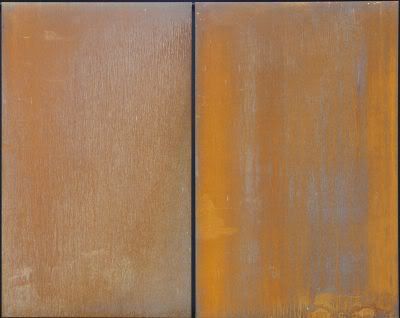 Upon further reflection of Variable Wedge by Sam Richardson, there are other aspects of the sculpture that are necessary to look at when analyzing its rhetorical value. Building upon the materials used, as briefly mentioned in the previous post, the sculpture is not only made out of Cor-Ten Steel, but this steel is then situated on top of a cement foundation beneath it. In this way, not only does the steel have a strong and sturdy structure, but the concrete only further solidifies this form. This rigid, geometric figure produces a stable reaction to the viewer, as if the form is where it is supposed
Upon further reflection of Variable Wedge by Sam Richardson, there are other aspects of the sculpture that are necessary to look at when analyzing its rhetorical value. Building upon the materials used, as briefly mentioned in the previous post, the sculpture is not only made out of Cor-Ten Steel, but this steel is then situated on top of a cement foundation beneath it. In this way, not only does the steel have a strong and sturdy structure, but the concrete only further solidifies this form. This rigid, geometric figure produces a stable reaction to the viewer, as if the form is where it is supposed to be, and not moving from that state. Despite this, there is a definite narrative in the progression of the wedge, which sort of juxtaposes this stationary feeling, and provides some movement for the sculpture.
to be, and not moving from that state. Despite this, there is a definite narrative in the progression of the wedge, which sort of juxtaposes this stationary feeling, and provides some movement for the sculpture. As far as the other chemical and visual properties of these two materials, Cor-Ten steel is meant to weather from its original state, while concrete remains relatively the same except for cracking due to shifts in the ground. With the steel, a chemical, corrosive process produces a protective layer of rust on the outside when exposed to outdoor elements over time. This is particularly interesting, as this changes the color of the sculpture, with the exception of the sides painted with the bright hues. Visually, it is somewhat obvious that the appearance of Variable Wedge will change over time due to this chemical change, especially its color. In addition, however, its form will shift slightly as well. When the Wedge was first created and assembled in its current location, one can assume that great care was taken to situate it in a manner parallel to Westbrook Music Building, but also to place each section of the wedge in-line with the other sections. Although this linear progression is still a major effect conveyed to the viewer, when one views the sculpture from the West, it is obvious that the first four sections have shifted slightly. In this manner, there are slight discrepancies between these sections, which I would imagine Richardson would have thought about when he created Wedge. Rhetorically, this can be conveyed through a logos lens as pertaining to the variance experienced in one's life: areas of tension, etc.
Lastly, when talking about the positioning of the entire piece, especially when viewed from the West looking East, one notices how the form of the sculpture points out into space. The tops of each of the sections extend upwards, so that since the piece is located on a hill, it gives the viewer a feeling that they are being shot up into the sky. When applied to this theme of life that the sculpture insinuates, this gesture is quite fitting, as it implies setting high goals for ones self. "If you shoot for the moon, you will land among the stars."
No comments:
Post a Comment